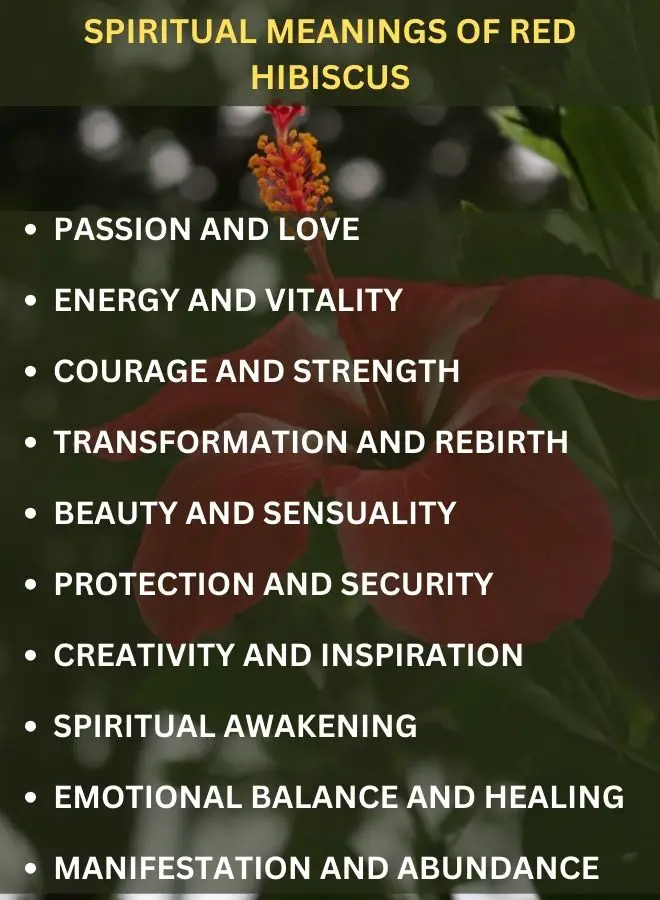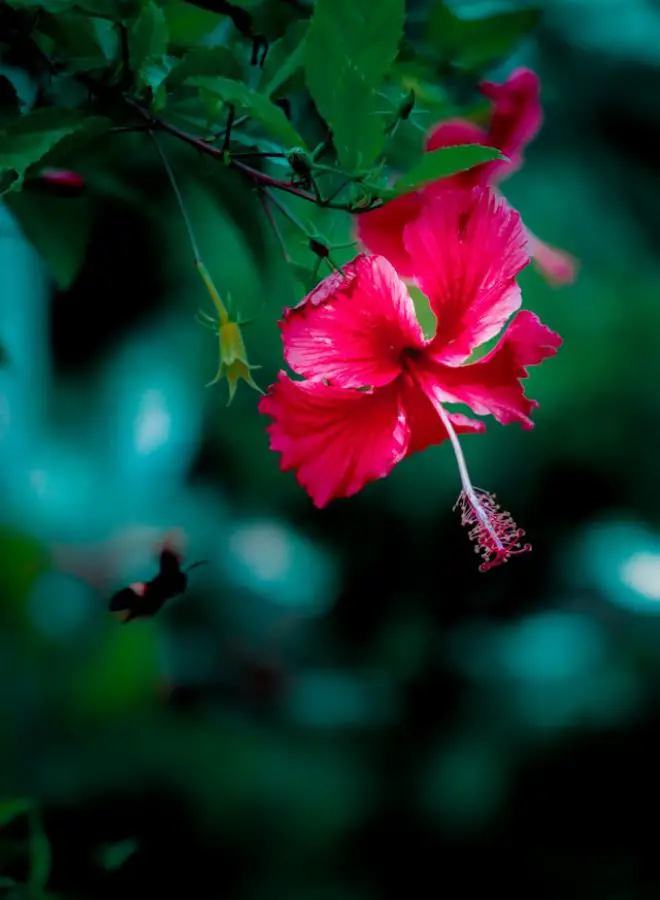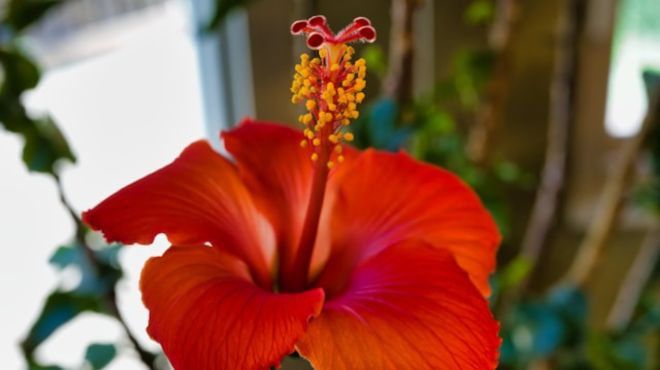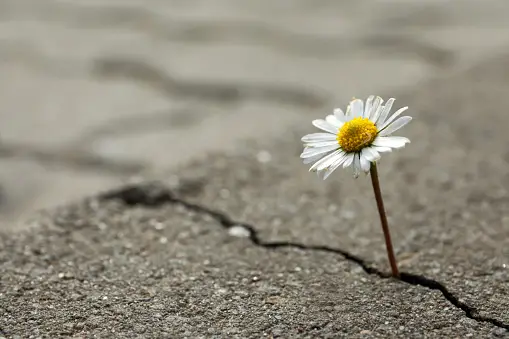The red hibiscus symbolizes passion, energy, courage, transformation, beauty, protection, creativity, spiritual awakening, emotional balance, and abundance, offering healing and inspiration to all.
Ah, the majestic red hibiscus! Its vibrant petals captivate the eye and stir the soul. But did you know that beyond its beauty lies a profound spiritual meaning? Join me on a journey as we delve into the mystical realm of the red hibiscus and uncover its hidden significance.
Spiritual Meanings of Red Hibiscus
Now, let’s explore the spiritual meanings attributed to this magnificent flower:

1. Passion and Love
The red hibiscus, with its vibrant hue, serves as a potent symbol of fiery passion and profound love. Its bold color ignites the senses, evoking the intensity of romantic desire and the warmth of heartfelt affection.
Whether gifted to a loved one or admired in nature’s embrace, the red hibiscus embodies the essence of love in its purest form.
2. Energy and Vitality
Like a beacon of light amidst the darkness, the red hibiscus radiates boundless energy and vitality. Its vibrant presence invigorates the spirit, infusing life with renewed vigor and zest.
Whether adorning a garden or gracing a bouquet, the red hibiscus serves as a reminder to embrace each moment with passion and enthusiasm, embracing the fullness of life’s abundant energy.
3. Courage and Strength
In the face of adversity, the red hibiscus stands tall as a symbol of courage and resilience. Its sturdy stems and resilient petals remind us to persevere in times of challenge, embodying the strength and fortitude needed to overcome life’s obstacles.
With each bloom, the red hibiscus inspires us to face our fears head-on and emerge victorious, empowered by the courage within.
4. Transformation and Rebirth
Just as the hibiscus blooms anew with each passing season, so too does it symbolize the transformative power of change and renewal. From bud to blossom, the red hibiscus undergoes a journey of growth and evolution, shedding its old self to embrace the beauty of transformation.
In its delicate petals, we find the promise of new beginnings and the eternal cycle of life’s ever-changing landscape.
5. Beauty and Sensuality
With its captivating beauty and graceful form, the red hibiscus exudes an aura of sensuality and allure. Its velvety petals beckon with a subtle invitation, enticing us to revel in the splendor of nature’s creation.
Whether admired from afar or savored up close, the red hibiscus celebrates the inherent beauty and grace of the human spirit, reminding us of the power of self-love and acceptance.
6. Protection and Security
In many cultures, the red hibiscus is revered for its protective properties, serving as a guardian against negative energies and malevolent forces. Its vibrant petals act as a shield, warding off harm and instilling a sense of security in those who seek its shelter.
Whether worn as an amulet or displayed in a sacred space, the red hibiscus offers reassurance and peace of mind, safeguarding the soul from harm’s way.
7. Creativity and Inspiration
Inspired by the red hibiscus’s vibrant colors and graceful form, artists and poets alike find renewed creativity and inspiration. Its intricate patterns and delicate petals serve as a muse for creative expression, igniting the imagination and sparking new ideas.
Whether captured on canvas or woven into verse, the red hibiscus inspires us to embrace our innate creativity and unleash the boundless potential within.
8. Spiritual Awakening
For those on a spiritual journey, the red hibiscus serves as a gentle reminder to awaken to the divine presence within. Its radiant petals symbolize the blossoming of the soul, guiding us towards enlightenment and inner peace.
Whether meditating in its presence or simply admiring its beauty, the red hibiscus invites us to explore the depths of our spiritual nature and embrace the interconnectedness of all living beings.
9. Emotional Balance and Healing
In times of emotional turmoil, the red hibiscus offers solace and healing, restoring inner harmony and balance. Its soothing presence calms the mind and uplifts the spirit, providing a sense of comfort and reassurance in times of need.
Whether steeped into tea or simply admired in nature’s embrace, the red hibiscus serves as a gentle reminder that healing is a journey of self-discovery and self-care.
10. Manifestation and Abundance
By cultivating a deep connection with the red hibiscus, one can tap into the universal flow of abundance and manifest their heart’s desires. Its vibrant energy aligns with the law of attraction, empowering us to attract positivity and prosperity into our lives.
Whether visualizing our goals or setting intentions with each bloom, the red hibiscus serves as a powerful ally on our journey towards fulfillment and abundance.
Variations and Spiritual Meanings of Red Hibiscus
Across different cultures and traditions, the red hibiscus takes on various symbolic meanings:
Chinese Symbolism: Luck and Prosperity
In Chinese culture, the red hibiscus is cherished for its association with good fortune, prosperity, and success. Its vibrant red petals symbolize wealth and abundance, making it a popular choice for decorations during festivals and celebrations.
By cultivating red hibiscus plants, individuals seek to invite prosperity and blessings into their lives, believing in its auspicious energy to bring luck and financial prosperity.
Native American Traditions: Connection to Ancestors
Among Native American tribes, the red hibiscus holds deep significance as a sacred symbol of ancestral wisdom and guidance. Revered for its vibrant color and striking beauty, the red hibiscus is often used in ceremonies and rituals to honor the spirits of ancestors and seek their guidance and protection.
Through its presence, individuals feel a profound connection to their roots and a sense of reverence for the wisdom passed down through generations.
African Cultures: Symbol of Femininity and Fertility
In many African cultures, the red hibiscus is celebrated as a powerful symbol of femininity, fertility, and the divine feminine. Its lush blooms and vibrant color evoke images of vitality and abundance, making it a favored motif in traditional artwork, clothing, and ceremonies.
Women may adorn themselves with red hibiscus flowers during rites of passage or fertility rituals, symbolizing their connection to the cycles of life, birth, and renewal.
Japanese Culture: Symbol of Short-Lived Beauty (Wabi-Sabi)
In Japan, the red hibiscus is revered for its fleeting beauty and association with the aesthetic philosophy of wabi-sabi. Embracing the impermanence of life, the red hibiscus serves as a reminder to cherish each moment and find beauty in the transience of existence.
Its delicate petals, which wither and fade over time, symbolize the ephemerality of youth and the inevitability of change, inspiring a sense of appreciation for the here and now.
Celtic Beliefs: Connection to Fire and the Divine
In Celtic mythology, the red hibiscus is intrinsically linked to the element of fire and the divine spark within each individual. Its fiery red petals symbolize passion, vitality, and the transformative power of the sacred flame.
By honoring the red hibiscus in rituals and ceremonies, practitioners seek to awaken the divine within themselves, harnessing its energy to ignite their inner fire and pursue their spiritual journey with courage and conviction.
Islamic Traditions: Symbol of Peace and Devotion
In Islamic tradition, the red hibiscus is esteemed as a symbol of peace, devotion, and the beauty of the soul. Its vibrant blooms evoke feelings of serenity and tranquility, serving as a reminder of the divine presence that permeates all creation.
Often used in Islamic art and architecture, the red hibiscus symbolizes the harmony and balance found in submission to the will of Allah, fostering a sense of inner peace and spiritual fulfillment.
Greek Mythology: Linked to the Goddess Aphrodite
In Greek mythology, the red hibiscus is intricately tied to the goddess Aphrodite, the embodiment of love, beauty, and desire. Legend has it that the red hibiscus first bloomed from the blood of the slain Adonis, her beloved companion.
As such, the red hibiscus is revered as a symbol of passionate love and romantic longing, representing the eternal bond between lovers and the enduring power of desire.
Mayan Civilization: Symbol of Life Force and Energy
Among the ancient Maya, the red hibiscus holds profound symbolism as a representation of the life force that animates all living beings. Its vibrant blooms and rich color palette mirror the vitality and energy of the natural world, symbolizing the interconnectedness of all living things.
Through rituals and offerings, the red hibiscus is honored as a sacred emblem of life, growth, and the divine essence that flows through the universe.
Tibetan Buddhism: Represents Love and Compassion
In Tibetan Buddhism, the red hibiscus is revered as a symbol of love, compassion, and the interconnectedness of all beings. Its radiant blooms and vibrant colors reflect the boundless love and compassion that emanate from the heart of the Buddha.
By cultivating red hibiscus plants and offering them as symbols of devotion, practitioners seek to cultivate loving-kindness and foster a sense of unity with all living creatures.
Hawaiian Culture: Sacred Offering and Celebration of Life
In Hawaiian culture, the red hibiscus holds special significance as a sacred offering to the gods and a symbol of celebration and joy. Its vibrant blooms adorn leis, wreaths, and ceremonial garlands, symbolizing the beauty and abundance of the islands.
By honoring the red hibiscus in rituals and ceremonies, Hawaiians express gratitude for the blessings of nature and the interconnectedness of all living things, celebrating life’s abundance with reverence and aloha.
Biblical and Hindu Symbolism of Red Hibiscus

The red hibiscus holds spiritual significance in both the Bible and Hindu scriptures:
Biblical References
In Christian scripture, the red hibiscus is often interpreted as a profound symbol of love, passion, and divine grace. Its vibrant red petals evoke the sacrificial love of Jesus Christ, who shed his blood for humanity’s redemption.
Moreover, the hibiscus’s fiery hue signifies the fervent passion and unwavering devotion of believers towards God. As a representation of divine grace, the red hibiscus serves as a poignant reminder of God’s boundless love and forgiveness towards all humankind.
Hindu Beliefs
In Hinduism, the red hibiscus holds profound significance as a sacred offering to revered deities like Goddess Kali and Lord Ganesha. Its vibrant petals symbolize devotion, embodying the deep reverence and spiritual commitment of devotees towards these divine beings. Additionally, the red hibiscus is associated with fertility, representing the creative power of the divine feminine and the abundance of blessings bestowed upon devotees.
Furthermore, its presence signifies spiritual awakening, serving as a catalyst for inner transformation and enlightenment among worshippers. Through rituals and prayers involving the red hibiscus, Hindus seek to deepen their connection with the divine and awaken to the sacred presence within themselves.
Cultural Significance of Red Hibiscus
The red hibiscus is deeply intertwined with cultural practices worldwide:
Rituals and Ceremonies
In numerous cultures, the red hibiscus takes center stage in rituals and ceremonies, embodying themes of love, prosperity, and spiritual purity. From weddings to religious rites, its vibrant blooms symbolize blessings and abundance, infusing sacred occasions with beauty and meaning.
Folklore and Mythology
Throughout the annals of history, the red hibiscus has woven its way into folklore and mythology, revered as a symbol of beauty, passion, and divine grace. Tales abound of its mystical origins and potent powers, captivating imaginations and inspiring awe in those who hear its stories.
Art and Literature
Artists and writers alike have been drawn to the red hibiscus’s enchanting beauty and symbolic significance. Through paintings, poems, and stories, they seek to capture its timeless allure and spiritual essence, immortalizing its vibrant blooms for generations to come.
In the world of art and literature, the red hibiscus stands as a testament to the enduring power of nature’s beauty and the human spirit’s quest for transcendence.
Enhancing Spiritual Life with Red Hibiscus
To enrich your spiritual journey with the red hibiscus:
Embrace Its Symbolism
Take a moment to delve into the spiritual meanings embodied by the red hibiscus. Reflect on its symbolism and how it resonates with your own journey of self-discovery and personal growth. Whether through meditation, journaling, or quiet contemplation, allow the essence of the red hibiscus to guide you towards deeper understanding and spiritual enlightenment.
Incorporate It Into Rituals
Infuse your daily rituals and ceremonies with the sacred energy of the red hibiscus. Whether by adorning your sacred space with fresh hibiscus flowers or brewing a cup of hibiscus tea as an offering to the divine, invite the essence of the red hibiscus into your spiritual practices.
By incorporating this sacred flower into your rituals, you can deepen your connection to the spiritual realm and foster a sense of reverence and gratitude.
Connect with Nature
Immerse yourself in the beauty and wisdom of nature by spending time in the presence of the red hibiscus in its natural habitat. Take a leisurely stroll through a garden or botanical preserve, allowing the vibrant colors and delicate fragrance of the red hibiscus to awaken your senses.
By connecting with nature in this way, you can cultivate a deeper appreciation for the interconnectedness of all living things and find solace and inspiration in the beauty of the natural world.
Share Its Beauty
Spread joy, love, and spiritual inspiration by sharing the beauty and symbolism of the red hibiscus with others. Whether by gifting a bouquet of hibiscus flowers to a loved one or sharing a cup of hibiscus tea with a friend, invite others to experience the transformative power of this sacred flower.
By sharing the beauty of the red hibiscus, you can uplift spirits, foster connections, and inspire others on their own spiritual journeys.
Conclusion
In conclusion, the red hibiscus is not just a flower—it is a sacred symbol of love, passion, and spiritual awakening. Whether admired for its beauty, brewed into tea, or incorporated into rituals, the red hibiscus holds the power to uplift the soul and ignite the spirit.
So, the next time you encounter this magnificent bloom, take a moment to pause, breathe, and connect with its timeless wisdom and divine grace.








